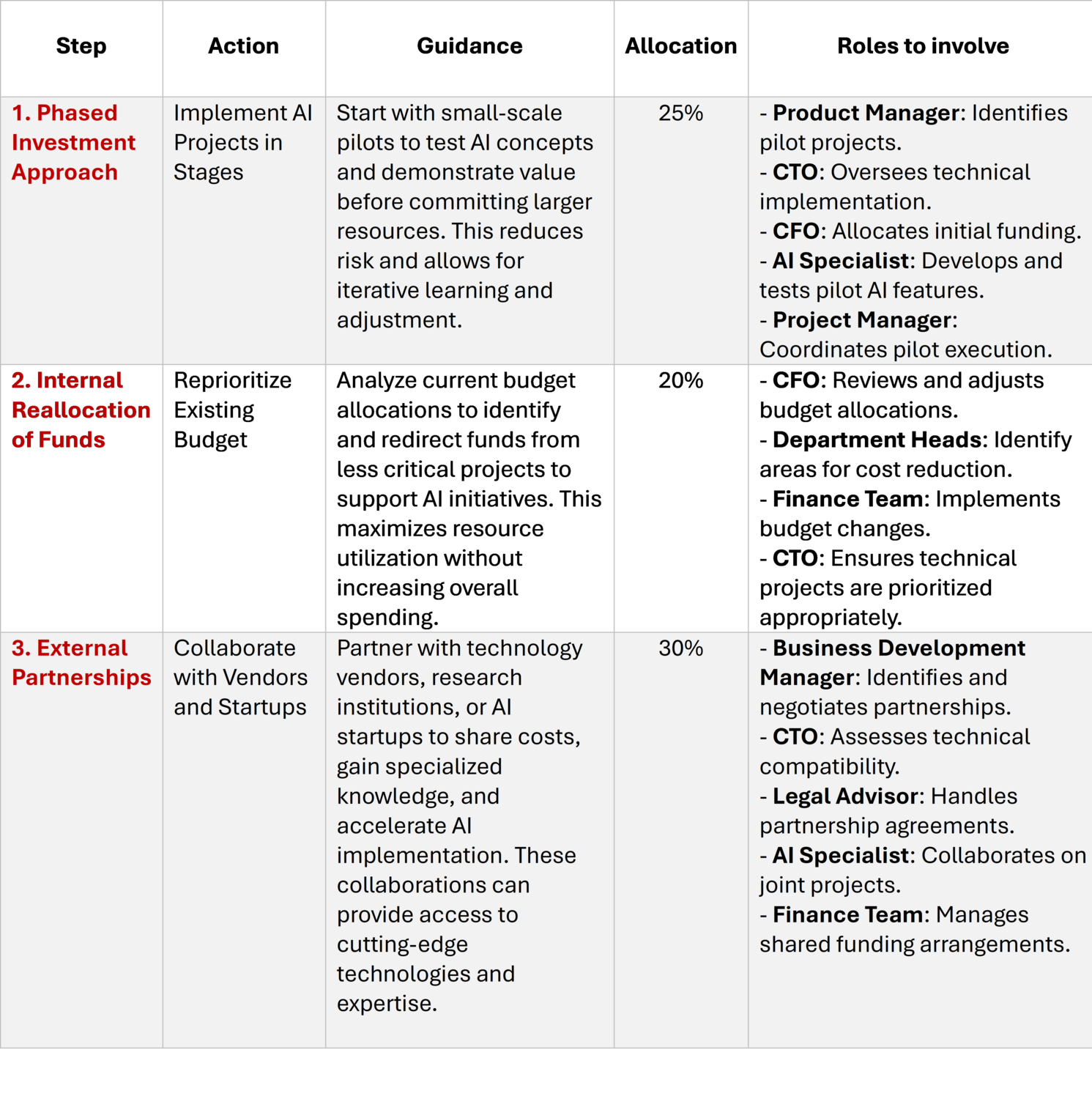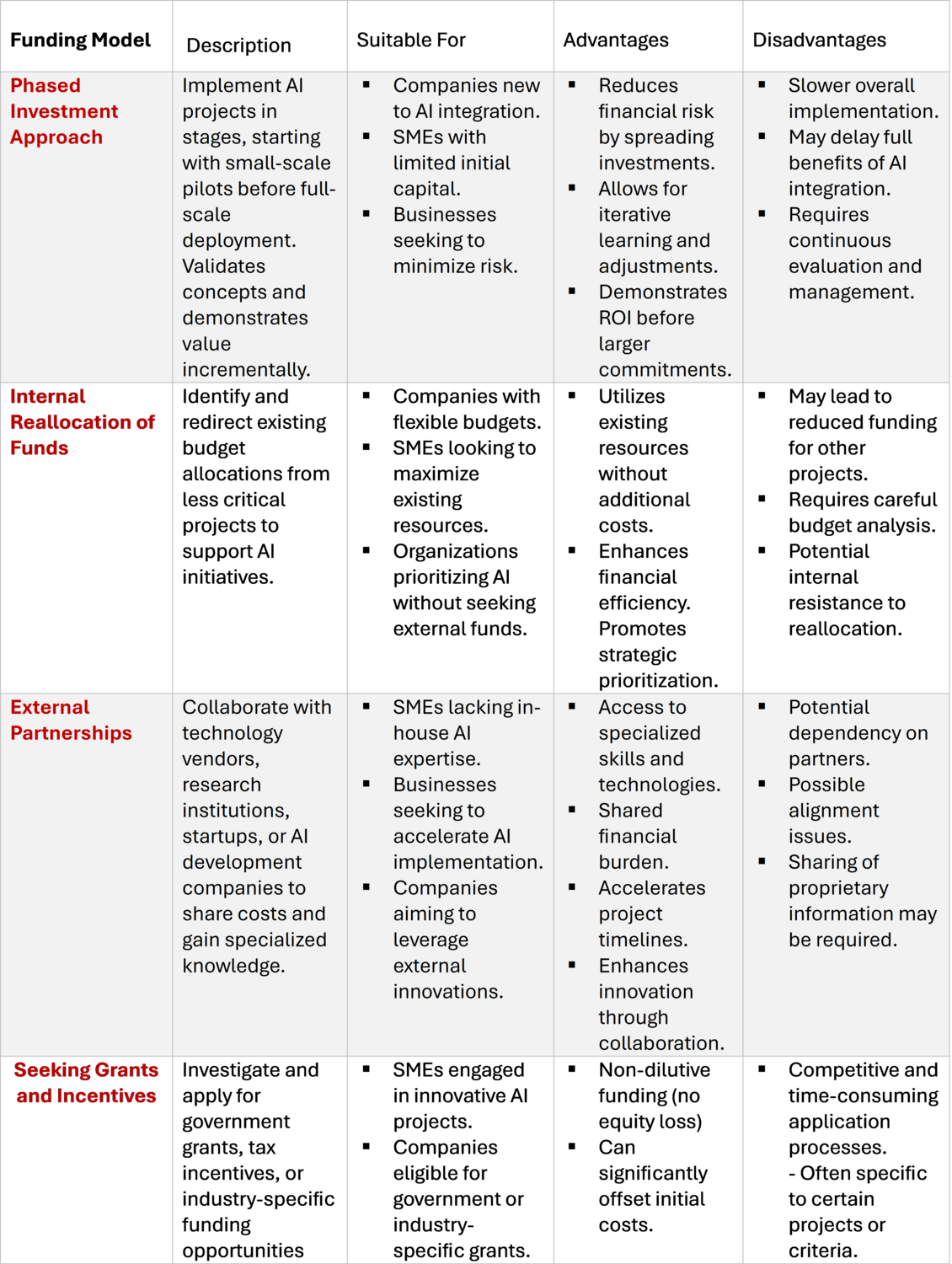Strategic AI Development: From Goals to Results in 2025
11.12.2024
AI has gone from a theoretical concept to an everyday game-changer, especially as we look ahead to 2025. The question isn’t whether to adopt AI, but how to do it in a way that truly aligns with your business goals. In this article, we explore practical strategies for embedding AI into your business operations effectively. We’ll cover how to align AI projects with your strategic objectives, create a clear and actionable roadmap, manage potential risks, and allocate your budget wisely. Whether you're looking to enhance customer experiences, streamline operations, or drive new growth opportunities, this guide provides the insights you need to make AI a powerful and integral part of your business strategy.
Aligning AI initiatives with business objectives
Before embarking on AI projects, it's crucial to ensure they directly support your organization's mission and objectives.
Define clear goals
Collaborate with an experienced AI development company to identify specific business challenges or opportunities where AI can make a significant impact. In 2025, consider focusing on the following areas:
- Operational Efficiency: Utilize AI to automate routine tasks, optimize supply chain management, and enhance predictive maintenance. For example, implementing AI-driven logistics can reduce delivery times and cut costs by anticipating and mitigating potential disruptions.
- Enhanced Customer Experience: Leverage AI to deliver personalized customer interactions through advanced chatbots and recommendation engines. By 2025, AI will enable more sophisticated sentiment analysis, allowing businesses to respond to customer needs proactively and improve satisfaction scores.
- Innovation in Products and Services: Develop AI-powered offerings such as smart products integrated with Internet of Things (IoT) devices or AI-driven analytics platforms that provide deeper insights into consumer behavior. These innovations can open new revenue streams and differentiate your brand in the market.
- Sustainability and Corporate Responsibility: Implement AI solutions to monitor and reduce your environmental footprint. AI can optimize energy usage, manage waste more effectively, and support sustainable practices, aligning with growing consumer and regulatory demands for corporate responsibility.
Prioritize use cases
Evaluate potential AI applications based on their feasibility, expected return on investment (ROI), and alignment with strategic priorities. Focus on projects that offer quick wins and measurable benefits.
- AI-Powered Data Analytics: Deploy AI tools that can process and analyze large datasets in real-time, providing actionable insights for strategic decision-making. This can enhance market intelligence, product development, and customer targeting.
- Cybersecurity Enhancements: With the rise of sophisticated cyber threats, AI-driven security systems can proactively detect and respond to vulnerabilities faster than traditional methods, safeguarding your business assets and maintaining customer trust. "According to a report by Gartner, 80% of security solutions are expected to use AI and Machine Learning (ML) by 2025."
- Remote Work Optimization: As remote and hybrid work models become standard, use AI to improve virtual collaboration, automate workflow management, and enhance employee productivity through intelligent virtual assistants and performance analytics.
- Market Trend Forecasting: Implement AI solutions that analyze market trends and consumer behavior to anticipate shifts and identify new opportunities. This foresight can inform strategic pivots and investment decisions, keeping your business ahead of the competition.
Discover More Ideas on Digital Innovation
Stakeholder engagement
Bring key stakeholders from various departments into the conversation early on. Their perspectives can sharpen your goals and build broader support for AI initiatives across the organization. As we head into 2025, successful stakeholder engagement should focus on:
- Cross-Functional Teams: Establish AI committees that include members from IT, marketing, finance, operations, and other critical departments. This diversity ensures that AI projects address comprehensive business needs and leverage varied expertise.
- Transparent Communication: Maintain open lines of communication to keep stakeholders informed about AI project goals, progress, and outcomes. Regular updates and collaborative meetings can build trust and ensure alignment across the organization.
- Continuous Training and Education: Invest in ongoing training programs to upskill employees, enabling them to work effectively with AI tools. By 2025, creating a culture of ongoing learning will be crucial as AI technologies continue to evolve at a rapid pace.
Roadmapping the AI journey
Developing a roadmap provides a structured plan for your AI integration efforts, outlining the steps needed to achieve your goals. Here’s how C-level leaders can effectively roadmap their AI journey:
Short-term goals: pilot programs and proof-of-concept studies
- Pilot AI Projects in High-Impact Areas: Launch pilot programs in departments where AI can quickly demonstrate value, such as customer service with AI chatbots or supply chain with predictive analytics. For example, a pilot chatbot can enhance customer support by handling routine inquiries, freeing up human agents for more complex issues.
- Proof-of-Concept (PoC) Studies: Conduct PoCs to validate AI technologies before full-scale implementation. This could involve testing machine learning models for demand forecasting or experimenting with Natural Language Processing (NLP) for automated report generation. Successful PoCs provide evidence of AI’s potential and build confidence among stakeholders.
Long-term goals: scaling and integration across the organization
- Expand Successful Pilots Organization-Wide: Once pilot projects prove successful, develop plans to scale these AI solutions across the entire organization. For instance, if an AI-driven inventory management system reduces stockouts in one region, roll it out to all distribution centers to achieve broader efficiency gains.
- Integrate AI into Core Business Processes: Embed AI into fundamental operations such as product development, marketing, and finance. By 2025, integrating AI into your enterprise resource planning (ERP) systems can streamline workflows, enhance data accuracy, and support real-time decision-making.
- Continuous Innovation and Upgradation: Establish a long-term vision for AI that includes regular updates and innovations. As AI technologies evolve, ensure your roadmap accommodates advancements like generative AI for creative tasks or Edge AI for real-time data processing in IoT applications.
4 Steps for Building a Winning AI Strategy in Finance

Risk management and mitigation
Proactively identifying and managing risks associated with AI integration is essential for minimizing disruptions and ensuring project success.
Technology-Related Risks
- System Integration Challenges: A software development team with expertise in system integration can help overcome challenges when merging AI tools with legacy systems. For instance, merging AI-driven customer relationship management (CRM) tools with older databases may require significant customization and testing to ensure seamless data flow and interoperability.
- Scalability Issues: As AI applications grow, ensuring that infrastructure can handle increased data processing and computational demands is crucial. A retail company expanding its AI-powered recommendation engine must ensure that its cloud infrastructure scales efficiently during peak shopping seasons.
Data-Related Risks
- Privacy Concerns: With stricter data protection regulations like GDPR and CCPA, safeguarding customer data used in AI models is critical. A financial institution using AI for fraud detection must implement robust encryption and anonymization techniques to protect sensitive information.
- Data Quality Issues: AI models rely on high-quality data for accurate predictions. Inaccurate or incomplete data can lead to flawed outcomes. For example, a healthcare provider utilizing AI for diagnostic purposes must ensure that patient records are comprehensive and error-free to avoid misdiagnoses.
Leading in the AI Landscape - Data and Security for LLM-s | TechZone
Organizational Factors
- Resistance to Change: Employees may resist AI adoption due to fear of job displacement or unfamiliarity with new technologies. A manufacturing company introducing AI-driven automation must address employee concerns through transparent communication and upskilling programs.
- Skill Gaps: Successfully implementing AI requires specialized skills that may be lacking within the current workforce. A marketing firm aiming to leverage AI for customer insights may need to hire data scientists or invest in training existing staff to bridge the expertise gap.
Develop contingency plans
For each identified risk, establishing robust contingency plans ensures that potential issues can be swiftly addressed, minimizing their impact on AI projects:
- Redundancy Systems: Implementing backup systems can prevent data loss and maintain operations during technical failures. For instance, an e-commerce platform using AI for inventory management should have redundant servers to ensure continuous functionality during outages.
- Upskilling Programs: Providing ongoing training helps employees adapt to AI-driven changes. A logistics company deploying AI for route optimization can offer training sessions to help drivers and planners understand and utilize the new system effectively.
- Flexible Scheduling: Adjusting project timelines can accommodate unforeseen delays. If an AI-powered customer service chatbot requires more development time than anticipated, extending the timeline ensures a polished and reliable final product.
Legal and regulatory compliance
Staying informed about evolving regulations governing AI, data protection, and privacy is crucial to avoid legal complications and maintain stakeholder trust:
Industry-Specific Regulations
- Healthcare Compliance: AI applications in healthcare must comply with regulations like HIPAA in the United States, ensuring patient data is handled with the highest standards of privacy and security.
- Financial Services Regulations: AI tools used for financial forecasting or risk assessment must adhere to regulations set by bodies like the Securities and Exchange Commission (SEC) to ensure transparency and fairness.
Ethical AI Practices
- Bias Mitigation: Mitigating bias in AI models is both a legal obligation and an ethical commitment. For instance, an AI-driven hiring platform should actively prevent discrimination against candidates based on gender, race, or age.
- Explainability and Transparency: Providing clear explanations of how AI decisions are made enhances accountability. For example, an insurance company using AI to determine policy premiums should be able to explain the factors influencing each decision to both customers and regulators.
Strategic considerations
- Leverage a Dedicated Team: Establishing a dedicated team focused on AI can accelerate development and implementation. This team should consist of members with diverse skills, including technical experts, project managers, and business analysts. According to Gartner, by 2030, 80% of the Project Management tasks will be performed utilizing AI.
- Partner with an AI Development Company: Collaborating with an experienced AI development company can provide access to specialized expertise and resources. Such partnerships can help you navigate complex AI technologies and implement solutions more efficiently.
- Measure and Monitor Progress: Implement key performance indicators (KPIs) to track the success of your AI initiatives. Regularly reviewing these metrics allows you to make data-driven decisions and adjust your strategy as needed.
Budgeting for AI development
Investing in AI is a significant strategic decision that requires careful financial planning. A well-structured budget ensures that your AI initiatives are feasible, sustainable, and aligned with your organization's financial capacity and strategic objectives.
Investment planning
Effective investment planning is the cornerstone of successful AI integration.
- Estimating Costs: Begin by identifying all potential costs associated with AI development. This includes expenses for software licenses, hardware upgrades, cloud services, and data acquisition. Factor in costs for pilot projects, development, testing, deployment, and ongoing maintenance of AI systems.
- Talent Acquisition and Training: Allocate budget for hiring skilled professionals such as data scientists, Machine Learning engineers, and AI specialists. If hiring is not immediately feasible, consider partnering with an AI development company to access the necessary expertise. Additionally, set aside funds for training existing staff to work effectively with new AI technologies.
- Infrastructure Upgrades: Assess whether your current technological infrastructure can support AI workloads. You may need to invest in high-performance computing resources, storage solutions, or network enhancements to handle increased data processing demands.

Cost-benefit analysis
Conducting a thorough cost-benefit analysis helps in understanding the financial implications and potential returns of your AI initiatives.
- Calculating Expected ROI: Estimate the tangible benefits that AI projects are expected to deliver. This could include increased revenue through improved products or services, cost savings from operational efficiencies, or enhanced customer retention.
- Evaluating Intangible Benefits: Consider intangible benefits such as improved decision-making capabilities, better customer experiences, and competitive advantages. While harder to quantify, these factors can significantly contribute to long-term success.
- Balancing Short-Term and Long-Term Gains: Recognize that AI investments may not yield immediate returns. Balance projects that offer quick wins with those that provide substantial long-term value, ensuring a mix that supports both immediate and strategic goals.
Funding models and partnerships
Exploring different funding strategies can optimize your investment and reduce financial risk.
- Phased Investment Approach: Implement AI projects in stages, starting with small-scale pilots before full-scale deployment. This approach allows you to validate concepts and demonstrate value before committing larger resources.
- Internal Reallocation of Funds: Identify areas within your current budget where funds can be reallocated to support AI initiatives. This might involve reprioritizing projects or reducing expenditures in less critical areas.
- External Partnerships: Collaborate with technology vendors, research institutions, or startups to share costs and gain access to specialized knowledge. Partnering with an experienced AI development company can also accelerate implementation and provide valuable insights.
- Seeking Grants and Incentives: Investigate government grants, tax incentives, or industry-specific funding opportunities that support innovation and AI adoption. These can offset initial investment costs and make projects more financially viable.

Strategic considerations
- Risk Mitigation: Include contingency funds in your budget to address unforeseen expenses or challenges that may arise during development and deployment.
- Transparency and Accountability: Establish clear governance structures for budget oversight. Regularly review expenditures against the budget to ensure accountability and enable timely adjustments.
- Alignment with Business Strategy: Ensure that your budgeting decisions are closely aligned with your overall business strategy. Investments should directly support strategic objectives and deliver measurable value.
Final thoughts on AI development in 2025
In 2025, AI integration is a strategic necessity, reshaping how businesses innovate, operate, and compete. Success requires aligning AI initiatives with business goals, mitigating risks, and ensuring thoughtful execution. Partnering with an experienced AI development company, such as Accedia, offers the expertise needed to navigate complexities, deliver tailored solutions, and achieve measurable results. By embedding AI into your core strategy and leveraging expert support, your business can unlock transformative opportunities, drive innovation, and secure a sustainable competitive edge in the evolving digital landscape.